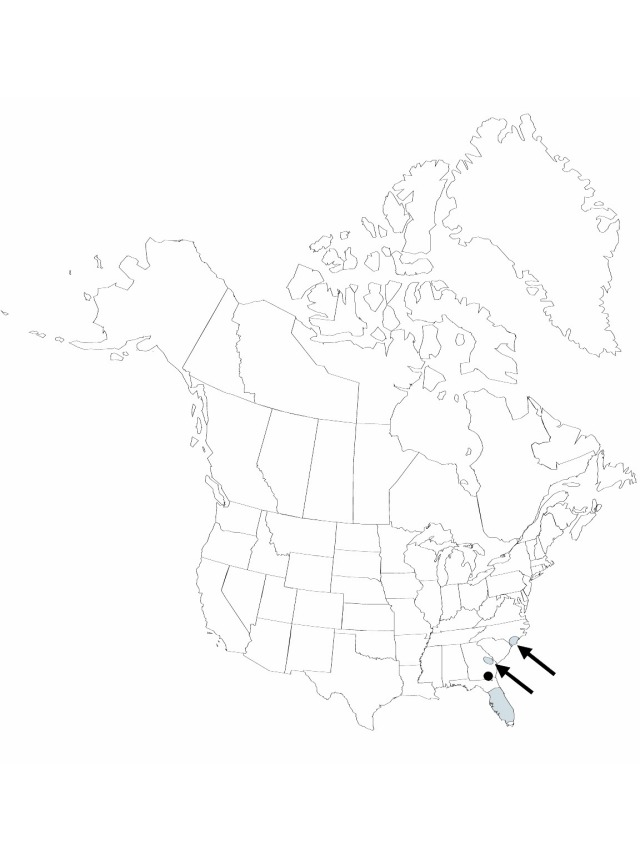Difference between revisions of "Lachnocaulon beyrichianum"
Linnaea 27: 567. 1856.
FNA>Volume Importer |
FNA>Volume Importer |
||
| Line 23: | Line 23: | ||
|elevation=0–100 m | |elevation=0–100 m | ||
|distribution=Fla.;Ga.;N.C.;S.C. | |distribution=Fla.;Ga.;N.C.;S.C. | ||
| − | |discussion=<p>Through its range Lachnocaulon beyrichianum is sympatric with L. anceps; it has narrower, more glabrous foliage, smaller heads, darker bracts, and smoother, more lustrous seeds. Where the two are in the same site, L. beyrichianum takes the drier substrata.</p><!-- | + | |discussion=<p>Through its range <i>Lachnocaulon beyrichianum</i> is sympatric with <i>L. anceps</i>; it has narrower, more glabrous foliage, smaller heads, darker bracts, and smoother, more lustrous seeds. Where the two are in the same site, <i>L. beyrichianum</i> takes the drier substrata.</p><!-- |
--><p>Of conservation concern.</p> | --><p>Of conservation concern.</p> | ||
|tables= | |tables= | ||
| Line 48: | Line 48: | ||
|publication year=1856 | |publication year=1856 | ||
|special status= | |special status= | ||
| − | |source xml=https://jpend@bitbucket.org/aafc-mbb/fna-data-curation.git/src/ | + | |source xml=https://jpend@bitbucket.org/aafc-mbb/fna-data-curation.git/src/8f726806613d60c220dc4493de13607dd3150896/coarse_grained_fna_xml/V22/V22_348.xml |
|genus=Lachnocaulon | |genus=Lachnocaulon | ||
|species=Lachnocaulon beyrichianum | |species=Lachnocaulon beyrichianum | ||
Revision as of 16:57, 18 September 2019
Herbs, perennial, cespitose, forming domes of rosettes, 15–23 cm. Leaves narrowly linear, abruptly attenuate, 1.5–4 cm, apex subulate. Inflorescences: scape sheaths shorter than leaves; scapes filiform, 0.5 mm wide, obscurely ridged, proximally densely pilose with ascending hairs, distally glabrous or nearly so; mature heads dull gray-brown or pale gray, globose to short cylindric, 3.5–4(–5) mm wide; receptacle pilose with translucent hairs; outer involucral bracts reflexed, brown to chestnut brown, ovate, 1 mm, apex obtuse, abaxially pilose; inner bracts distally brown, broadly spatulate or pandurate, 1–1.5(–2) mm, apex obtuse, pilose-ciliate, adaxially pilose with whitish, mealy, opaque, club-shaped hairs. Staminate flowers: sepals 3, brown to chestnut brown, oblanceolate-spatulate, 1–1.5(–2) mm, apex obtuse, ciliate, abaxially with white, mealy, opaque hairs; androphore pale, club-shaped, as long as sepals, glabrous; stamens 3, appendages 3. Pistillate flowers: sepals 3, tan or pale brown, oblong to linear, 2–3 mm, apex acute, glabrous or abaxially pilose toward apex, hairs white; gynoecium 3-carpellate; stylar column pale, dilated apically, appendages 3. Seeds dark red-brown, very lustrous, ellipsoid, 0.5 mm, apex apiculate, longitudinal ribs faint, transverse ribs forming finely cross-striolate pattern.
Phenology: Flowering summer–fall.
Habitat: Sands and sandy peats, frequently dry pond shores, flatwoods, pine savanna, sandhills ecotones
Elevation: 0–100 m
Distribution

Fla., Ga., N.C., S.C.
Discussion
Through its range Lachnocaulon beyrichianum is sympatric with L. anceps; it has narrower, more glabrous foliage, smaller heads, darker bracts, and smoother, more lustrous seeds. Where the two are in the same site, L. beyrichianum takes the drier substrata.
Of conservation concern.
Selected References
None.